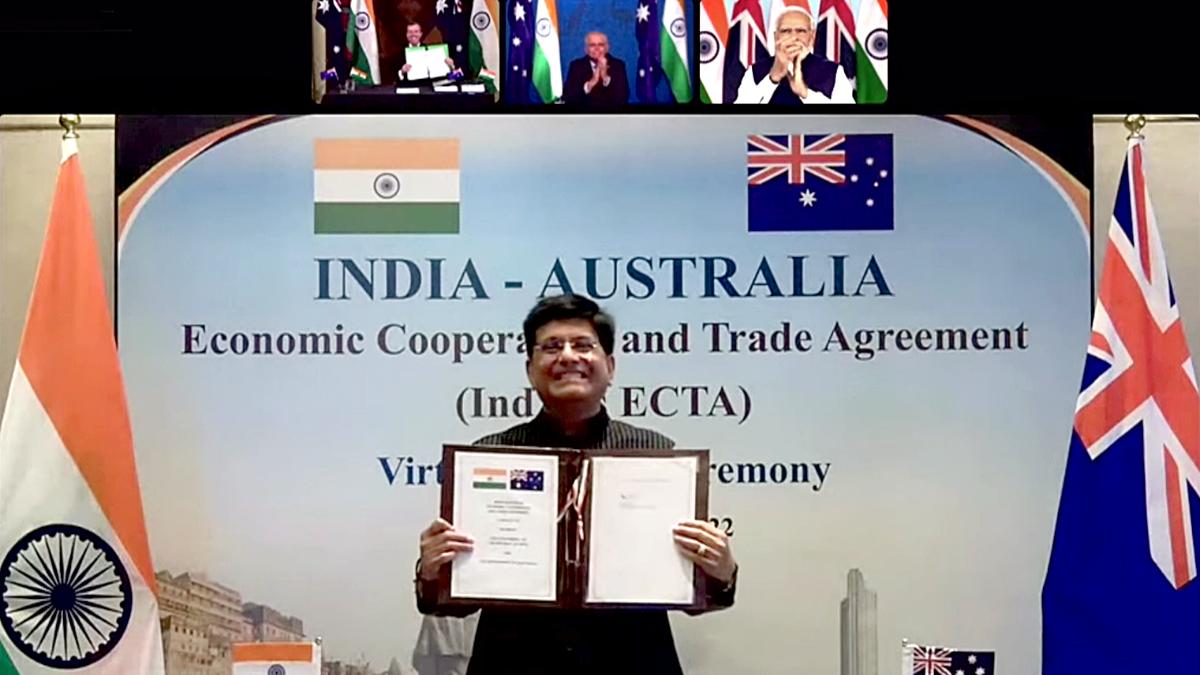Live Classes

India-Australia ECTA is a landmark in bilateral relations, will deepen ties
The ratification of the India-Australia Economic Cooperation and Trade Agreement (ECTA) by the Australian parliament on Tuesday demonstrates India’s skill in trade negotiations. The deal sailed smoothly through the Australian parliament, despite the fact that it was negotiated when the Liberal Party was in power and signed on April 2, 2022, and Labour came to power in May. This is salient also because most free trade deals New Delhi has negotiated and entered into have been mostly with South Asian countries and hardly served India’s trade interests. Rather, they became counterproductive.
India-Australia ECTA and dispute
Prime Minister Narendra Modi and his Australian counterpart Prime Minister Anthony Albanese and Commerce Minister, Piyush Goyal and his counterpart, Trade, Tourism and Investment Minister of Australia, Don Farrell need to be complemented for striking the first trade deal with a developed country in a decade. On the one hand, it provides an opportunity for Australian exporters to tap the vast Indian market of 1.4 billion consumers, on the other, it provides an opportunity for Indian exporters to market their value-added products.
Considerable preparation and hard work had gone into finalising the negotiating agenda. Indian negotiators must be complimented for managing to get exclusions for the most sensitive sectors, and dairy and agriculture. These provide employment in rural areas to about 50-55 per cent of its population with small landholdings and 1-2 cattle per farmer. This is in sharp contrast to Australian agriculture and dairying. This bone of contention had stood in the way of a free trade deal.
Common interests of India and Australia
India and Australia both are Commonwealth countries, and parliamentary democracies with similar legal systems. Besides, India and Australia also are members of the Quad, a trilateral Supply Chain Resilience Initiative (SCRI) and the Indo-Pacific Economic Framework (IPEF).
Share of China and India in trade with Australia
China is Australia’s largest trade partner with a 33 per cent share in its exports and a 27 per cent share in its imports, compared to India’s 3.7 per cent share in its exports and a 2.4 per cent share in its imports as of 2021. Strategically, the need for trade diversification away from China for Australia, in view of a multiplicity of geopolitical factors, significantly tilts the balance in favour of India, leading to a win-win partnership. Manufactured goods such as petroleum, medicaments, diamonds, jewellery, railway coaches and vehicles, milled rice and herbicides constitute 72 per cent of India’s exports to Australia. India primarily imports raw materials. Eighty-two percent of its imports from Australia are coal, gold, copper ore, aluminium oxide, liquified natural gas, manganese ore, aluminium waste, pigments, lentils, etc.
Benefits from India-Australia ECTA
The Ind-Aus ECTA will lead to duty elimination on 100 percent tariff lines with no restrictions and benefit India’s labor-intensive exports such as textiles and apparel, agriculture and fish products, leather, footwear and furniture, several engineering products, jewelry, select pharmaceutical and medical devices, furniture, and sports goods. These now fetch 4-5 percent import duty in the Australian market. The agreement would provide duty-free access to over 6,000 broad categories of Indian products in the Australian market. The trade deal will boost exports of pharmaceuticals, India’s second-largest export after petroleum products, to Australia, as medicaments that have already been approved in the US and the UK will get expeditious regulatory approval from Australian authorities.
Why is ECTA important for India?
India is the world’s largest importer of coal. Out of India’s coal trade deficit of $24 billion, Australia accounts for $11 billion. The Ind-Aus ECTA is likely to make coal, a crucial input for India’s energy needs and its industrial growth, available at competitive prices. Besides, duty-free imports of Australian raw materials such as copper, nickel, aluminum, manganese, wool, hide and skins, etc, would boost the competitiveness of Indian industry and create enormous job opportunities. Australia will also allow duty-free import of Indian wines, while India will reduce import duties from 150 percent to 100 percent on Australian wines of $5 per bottle, down to 50 percent in 10 years.
The Ind-Aus ECTA goes beyond merchandise trade and the Indian services sector also gets a major boost as it makes wide-ranging commitments in around 135 service sectors. The Most Favoured Nation (MFN) status will be granted in about 120 sub-sectors covering key areas of India’s interest such as IT, ITES, education, health, and audio-visual. The deal provides an annual quota of 1,800 for yoga teachers and Indian chefs and a commitment to over one lakh of India’s outgoing students to Australia, who are likely to benefit from post-study work visas ranging from one-and-half years to four years.
What's next
The Ind-Aus ECTA is expected to increase bilateral merchandise exports by $10 billion by 2026-27. It will contribute to the creation of additional job opportunities for Indians in Australia and an additional 10 lakh jobs in India as a result of Australian investments. The trade deal also resolves the long-pending Double Taxation Avoidance Agreement (DTAA) related to IT/ITES. This will lead to yearly savings of over $200 million, a remarkable achievement The trade deal will prove to be a milestone in India-Australia relations that will not only increase mutual cooperation but also significantly contribute to boosting economic growth and the strategic partnership between the two countries.
GS Paper - 2 (IR)
Download pdf to Read More